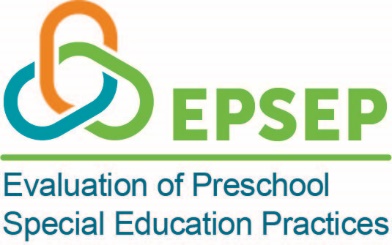Evaluation of Preschool Special Education Practices Efficacy Study
Evaluation of Preschool Special Education Practices Efficacy Study
Appendix H Teacher-Child Reports_clean_revised post IRB
Evaluation of Preschool Special Education Practices Efficacy Study
OMB: 1850-0916
APPENDIX H
teacher-child
reports
This page has been left blank for double-sided copying.


OMB No.: 1850-0916
Expiration Date: XX/XX/XXXX
According to the Paperwork Reduction Act of 1995, no persons are required to respond to a collection of information unless such collection displays a valid OMB control number. The valid OMB control number for this information collection is 1850-0916. The time required to complete this information collection is estimated to average 25 minutes, including the time to review instructions, search existing data sources, gather the data needed, and complete and review the information collection. If you have any comments concerning the accuracy of the time estimate or suggestions for improving this form, please write to: U.S. Department of Education, Washington, DC 20202. If you have comments or concerns regarding the content or the status of your individual submission of this form, write directly to: U.S. Department of Education, Institute of Education Sciences, 550 12th Street, SW, Washington, DC 20202.
INSTRUCTIONS |
|
Description of Instruments That Would Be Enclosed
Social Skills Improvement System (SSIS; Gresham & Elliott, 2008; 76 items)
Teachers will complete the Social Skills (46 items) and Problem Behaviors (30 items) sections of the SSIS. For each item, they will circle how often the child displays each behavior (never, seldom, often, or almost always). For each of the social skills items, they will circle how important the behavior is for success in their classroom (not important, important, or critical).
The SSIS is a proprietary instrument.
Clinical Evaluation of Language Fundamentals Preschool 2 (CELF P2; Wiig et al., 2004) Descriptive Pragmatics Profile (26 items)
Teachers will complete the Nonverbal Communication Skills (7 items), Conversational Routines and Skills (12 items), and Asking for, Giving, and Responding to Information (7 items) sections of the CELF P2 Descriptive Pragmatics Profile. For each item, they will circle how often the child demonstrates the skill (never, sometimes, often, or always).
The CELF P2 is a proprietary instrument.
ABILITIES Index (Simeonsson & Bailey, 1991; 9 items) (Fall only)
Each ability is rated on a scale of 1 to 6 with 1 indicating normal ability and 6 indicating extreme or profound lack of ability. Teachers will indicate the child’s ability level on Audition; Behavior and social skills; Intellectual function; Limbs; Intentional communication; Tonicity; Integrity of physical health; Eyes; and Structural status by placing an ‘x’ next to the appropriate space on the form.
This page has been left blank for double-sided copying.
| File Type | application/vnd.openxmlformats-officedocument.wordprocessingml.document |
| Author | Mathematica Policy Research |
| File Modified | 0000-00-00 |
| File Created | 2021-01-15 |
© 2025 OMB.report | Privacy Policy